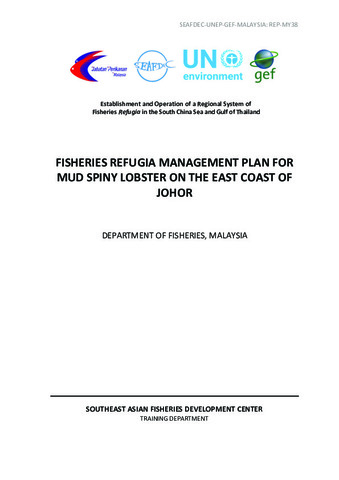| dc.contributor.author | DOF/Malaysia | |
| dc.date.accessioned | 2023-04-27T07:37:39Z | |
| dc.date.available | 2023-04-27T07:37:39Z | |
| dc.date.issued | 2022-12 | |
| dc.identifier.citation | DOF/Malaysia, 2022. Establishment and Operation of a Regional System of Fisheries Refugia in the South China Sea and Gulf of Thailand, Fisheries Refugia Management Plan for Mud Spiny Lobster on the East Coast Of Johor. Southeast Asian Fisheries Development Center, Training Department, Samut Prakan, Thailand; FR/REP/MY38, 120 p | en |
| dc.identifier.uri | http://hdl.handle.net/20.500.12067/1913 | |
| dc.description | This report is under the SEAFDEC/UNEP/GEF Project on “Establishment and Operation of a Regional System of Fisheries Refugia in the South China Sea and Gulf of Thailand” | en |
| dc.description.abstract | The Department of Fisheries Malaysia (DOFM) endorsed the concept of fisheries refugia as one of its efforts to sustain the lobster fisheries, particularly the protection of the lobster stock on the east coast of Johor. The fisheries refugia are a complementary effort to the present management framework that filled gaps, particularly for the mud spiny lobster. Nonetheless, fisheries refugia are not a replica of a marine protected area (MPA). The fisheries refugia emphasize long-term viability of the fishing industry, specifically resource sustainability. Hence, the vision of the fisheries refugia is to develop sustainable lobster fisheries on the east coast of Johor via its mission of implementing good practices as outlined in the fisheries refugia plan. In the context of conserving the mud spiny lobster stock on the east coast of Johor, over-fishing is the primary threat. The fisheries refugia will not achieve its goals if the lobster refugium is limited to the surrounding area of Tanjung Leman. After considering critical habitats for lobster, the sea current circulation pattern, species distribution, and the present fisheries activities in the area, the boundary of the fisheries refugium was re-delineated to cover the coastal water on the east coast of Johor. In addition, an area of 1,717 km2, located southward of Pulau Aur, was identified as the sensitive area for spawning within the lobster refugium. The fisheries refugia plan highlighted eight strategies to sustain the lobster fisheries in the designated refugium. | en |
| dc.description.sponsorship | UNEP/GEF | en |
| dc.language.iso | en | en |
| dc.publisher | SEAFDEC/TRAINING DEPARTMENT | en |
| dc.relation.ispartofseries | FR/REP/MY;38 | |
| dc.title | Fisheries Refugia Management Plan for Mud Spiny Lobster on the East Coast of Johor | en |
| dc.type | Working Paper | en |
| local.subject | south china sea | en |
| local.subject | fisheries refugia | en |
| local.subject | ecosystem approaches | en |

